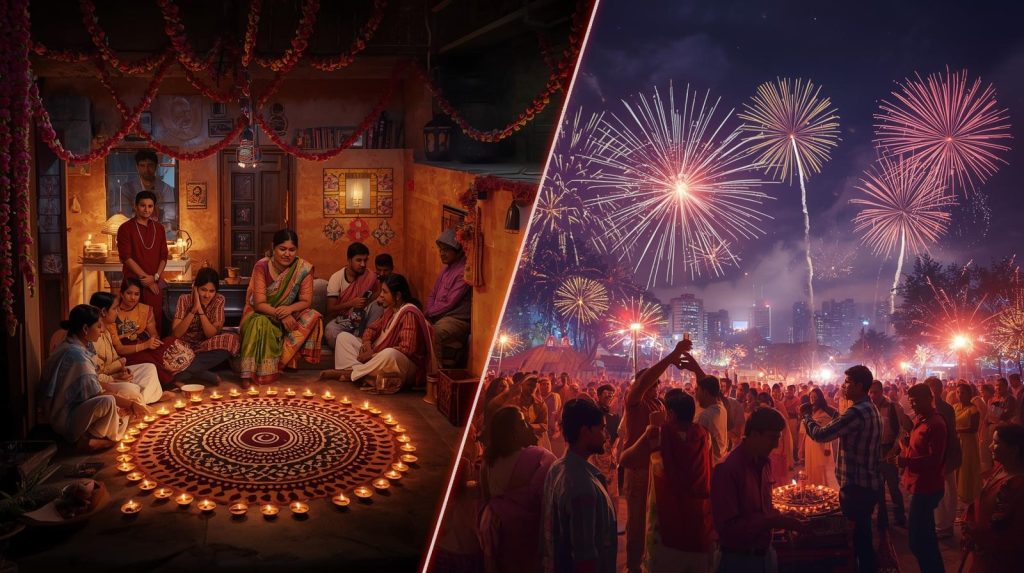
Unraveling Memories: A Deepavali of ‘100 Walas’ and Month-Long Kajjayya
Deepavali, the festival of lights, arrives every year with its signature glow. But for those of us who carry the memories of the 80s and 90s in our hearts, the festival’s brightest light is often the one cast by nostalgia. It was a time when the joy of Deepavali wasn’t just in the celebration itself, but in the long, delicious, and sometimes mischievous wait for it.
The Great Cracker Campaign
About fifteen days before Deepavali, a special kind of mission would commence in our homes. It was the “cracker campaign,” a relentless, strategic, and often dramatic effort to convince our parents to buy us fireworks. We would plead, promise to be good, and follow them around the house, our appeals growing more desperate as the big day neared.
The victory, however, was never absolute. The crackers wouldn’t appear until the actual day of the festival, and when they did, the quantity was always… limited. But this scarcity bred creativity. We quickly learned that true genius lay not in the big rockets, but in the humble ‘100 wala’—the long chain of tiny firecrackers. Instead of lighting the whole string for a minute of glorious noise, we would meticulously unravel it. Each tiny cracker was separated and saved. This wasn’t just about bursting crackers; it was about stretching time. We would place them one by one, light the fuse, and savour the tiny ‘pop’, making a handful of crackers last for what felt like an entire evening. It was our first lesson in resource management, taught by the sheer joy of a firecracker.
The All-Night Vigil for Kajjayya
While we schemed about crackers, another, more profound magic was brewing in the kitchen. The night before Deepavali, our house would be filled with the heavenly aroma of rice flour, jaggery, and hot oil. This was the night of the Kajjayya marathon.
Kajjayya, a deep-fried sweet pastry, was the undisputed king of our Deepavali sweets. This wasn’t a dish you could whip up in an hour. It was an all-night ritual. The women of the family would stay awake, transforming huge quantities of batter into perfectly puffed, golden-brown delicacies. The rhythmic sound of the dough being shaped and the sizzle of it hitting the hot oil was the festival’s true background score. We would wait for an entire year to taste it, and that year-long anticipation made every bite feel like a divine reward.
The Treasure in the ‘Vadi’: Our Snack for the Month
The labour of that night resulted in a treasure that would last for weeks. The freshly made Kajjayya would be carefully stored in a large metal container, or vadi. This vadi was our pantry, our snack bar, and our treasure chest for the next month.
Forget the packaged chips and biscuits of today. When we came home from school, our snack was a piece of homemade Kajjayya. When guests arrived, the vadi would be opened. It was a constant, delicious reminder of the festival, long after the last lamp had been put away. That container of sweets wasn’t just food; it was a vessel of our mother’s love and the lingering spirit of the celebration.
What About Today?
Today, the landscape of Deepavali has changed. Crackers are available in overwhelming variety, and the art of making a little last a long time feels like a forgotten craft. And in the world of sweets, the traditional Kajjayya often finds itself replaced by an assorted box of store-bought delicacies. Everything is instantly available. The year-long wait for a specific taste is a concept that belongs to another era. The snack cupboard is filled with endless options, not a single, precious treat from a festival vadi.
While today’s celebrations are bright with convenience and choice, there was a unique richness in that old-world Deepavali. It taught us patience, creativity, and the profound joy of savouring something rare. It was a festival where every cracker was a victory and every sweet was a story—a story that, thankfully, memory keeps safe and warm for us.


